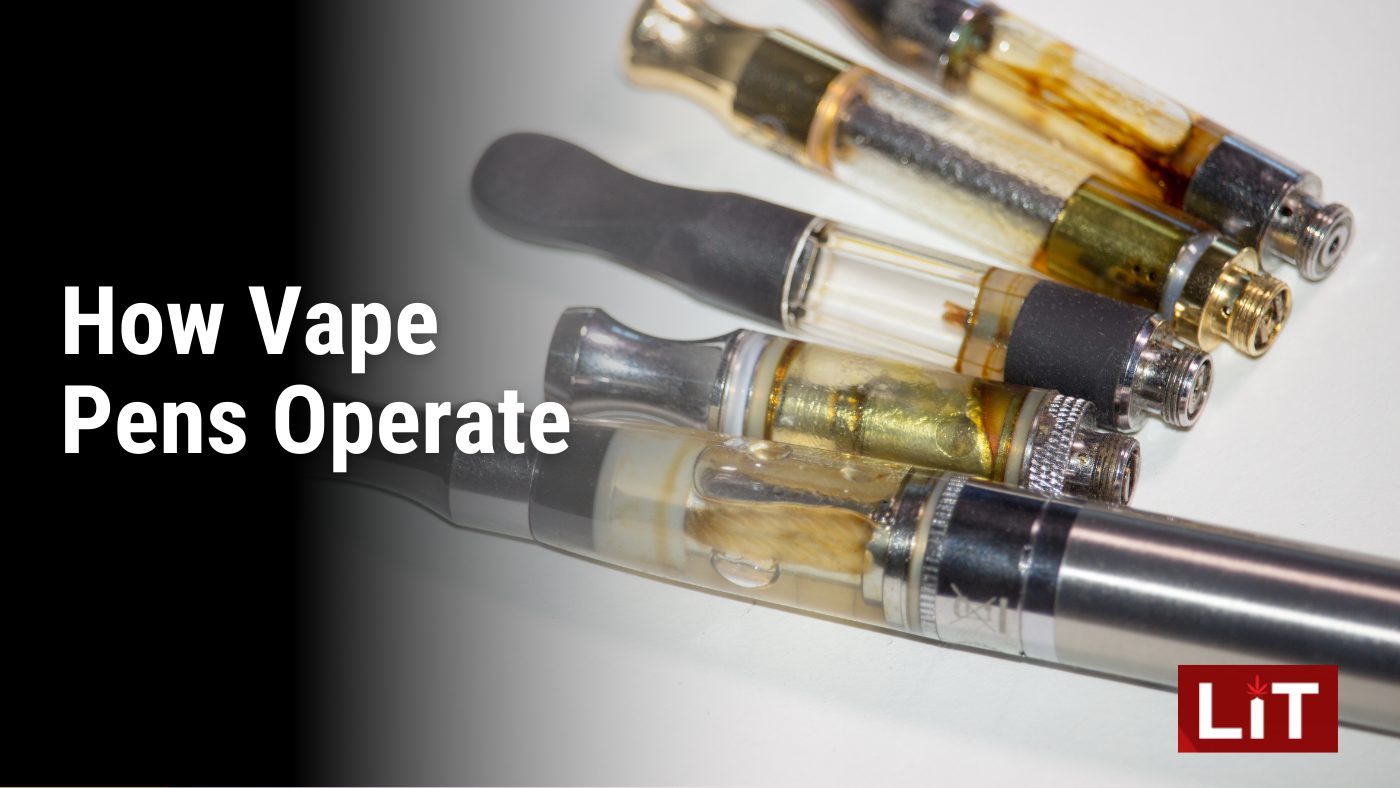Vaping has become a popular alternative to smoking, but many people are unsure about the rules and regulations when it comes to traveling with vape pens. This article will help you understand the components of a vape pen, how they work, and whether metal detectors can detect them. We’ll also cover important information about TSA regulations, airline policies, and legal considerations to ensure a smooth journey with your vape pen.
Key Takeaways
- Vape pens comprise a battery, a heating element, and a cartridge or tank.
- Vape pens must be carried in your carry-on luggage, not checked baggage.
- Most airlines do not allow the use of vape pens during flights.
- Countries have different laws regarding vape pens, so always check local regulations before traveling.
- Metal detectors can sometimes detect vape pens due to their metal components.
Understanding the Components of a Vape Pen

A vape pen is a simple yet effective device that vaporizes substances like e-juice, dry herbs, or concentrates. Knowing its parts helps you make an informed choice when buying one.
Battery and Power Source
The battery is the heart of the vape pen, providing the necessary power to heat the substance. Batteries come in various sizes and capacities, affecting the device’s overall performance and longevity. Some batteries are rechargeable, while others are disposable.
Heating Element and Atomizer
The heating element, often called the atomizer or coil, heats the substance to create vapor. This component can be made from different materials, such as kanthal, nickel, or ceramic, each offering unique benefits and drawbacks.
Cartridge or Tank
The chamber or cartridge holds the substance to be vaporized. Depending on the type of vape pen, cartridges can be pre-filled or refillable. The chamber’s quality and material can influence the vapor’s flavor and efficiency.
Knowing the basic parts of a vape pen helps you understand how they work and what to look for when buying one.
How Vape Pens Operate

Activation Process
When you draw on the mouthpiece of a vape pen, the battery activates the heating element. This heat turns the e-liquid into an aerosol, which you inhale into your lungs. The particles in the aerosol, including nicotine, are quickly absorbed into the bloodstream. This process mimics smoking but without burning any substance.
Aerosol Production
The vape pen’s heating element heats the e-liquid to a temperature that turns it into an aerosol. This aerosol contains tiny particles, including nicotine and flavorings, which are inhaled deeply into the lungs. Understanding this process is crucial for anyone looking to switch from traditional smoking.
Inhalation and Absorption
Once the aerosol is produced, it is inhaled through the mouthpiece and into the lungs. The nicotine and other substances in the aerosol are then absorbed into the bloodstream. This method of delivery is efficient and provides a quick way to get nicotine into the system. However, it also introduces various chemicals into the body, some of which have unknown long-term effects.
Knowing how vape pens work and their components is essential for anyone looking to switch from traditional smoking. While they offer a different way to get nicotine, they come with their own set of risks.
Common Misconceptions About Vape Pens
Many people mistakenly believe the aerosol from vape pens is just ‘water vapor.’ However, it contains tiny particles, including nicotine and flavorings, which are inhaled deeply into the lungs. This process introduces various chemicals into the body, some of which have unknown long-term effects.
Aerosol Composition
The aerosol produced by vape pens is often misunderstood. While it may look like harmless water vapor, it contains various chemicals. These include nicotine, flavorings, and other substances that can be harmful when inhaled. Understanding the actual composition of vape aerosol is crucial for making informed decisions.
Health Risks
Another common misconception is that vaping is entirely safe. While it may be less harmful than smoking traditional cigarettes, it is not without risks. Vaping can lead to lung damage, heart issues, and other health problems. The long-term effects are still being studied, but early evidence suggests that chronic use can have serious consequences.
Regulatory Differences
People often assume that all vape pens are regulated the same way. In reality, regulations can vary widely between countries and even states. Some places have strict rules about selling and using vape pens, while others are more lenient. It’s important to be aware of these differences to avoid legal issues.
Knowing how vape pens work and their components is essential for anyone looking to switch from traditional smoking. While they offer a different way to get nicotine, they come with their own set of risks.
TSA Regulations on Vape Pens
When traveling with vape pens, it’s crucial to understand the TSA regulations to avoid any issues at the airport. Vape pens are allowed on planes, but there are specific rules you must follow.
Carry-On vs. Checked Luggage
Vape pens must be kept in carry-on luggage or on your person. Due to safety concerns, they are not allowed in checked luggage. The temperature-regulated passenger compartment is safer for the batteries.
Battery Restrictions
The TSA has strict rules regarding batteries. Vape pens typically use lithium batteries, which must be carried onto the plane. These batteries can pose a fire risk if damaged or improperly stored, so they must undergo security screening with the traveler.
Liquid Limits for E-Liquids
E-liquids must comply with the TSA’s liquid rules. This means they should be in containers of 3.4 ounces (100 milliliters) or less and placed in a single, clear, quart-sized bag along with other liquids. This rule ensures that all liquids are easily identifiable through X-ray screening.
Remember, the TSA may inspect your vape pen more closely if there’s any ambiguity or suspicion regarding its contents. To avoid delays, make sure your vape pen and e-liquids are easily identifiable and comply with all regulations.
Airline Policies on Vaping Devices

When traveling with vape pens, it’s crucial to understand the rules set by different airlines to avoid any issues. Here’s a breakdown of what you need to know about various airlines’ stances on vaping devices.
Major Airlines’ Stances
Most major airlines allow passengers to bring vape pens on board, but they must be kept in carry-on luggage. This is primarily due to the lithium-ion batteries found in most vaping devices, which can pose a fire risk if stored in checked luggage. However, no airline permits the use of vape pens during the flight. Always check with your specific airline for their detailed policies.
International Travel Considerations
Traveling internationally with a vape pen adds another layer of complexity. Different countries have varying regulations regarding vaping devices. Some countries may have strict laws, including bans on importing vape pens. It’s essential to research the regulations of your destination country to avoid confiscation or legal issues.
In-Flight Usage Rules
Using a vape pen on a plane is strictly prohibited on all US airlines and most international carriers. You are responsible for ensuring your device does not accidentally activate during the flight. To prevent this, it’s advisable to disassemble your vape pen and store the components separately. This precaution helps avoid accidental “firing” of the device, which could cause safety concerns.
Remember, while you can bring your vape on board, you must resist the urge to use it until you’re in a designated smoking or vaping area after landing.
Legal Considerations for Traveling with Vape Pens
When traveling with vape pens, it’s crucial to understand the legal landscape to avoid any issues. Federal and state laws can vary significantly, and what is permissible in one state may not be allowed in another. Always check the specific regulations of your departure and destination locations to ensure compliance.
Federal vs. State Laws
Federal laws generally permit the transportation of vape pens, but state laws can impose stricter regulations. For instance, some states have specific restrictions on the types of e-liquids or devices that can be carried. It’s essential to be aware of these differences to avoid any legal complications.
International Regulations
Traveling internationally with vape pens adds another layer of complexity. Many countries have stringent laws regarding vaping devices, and some even ban them outright. Before you fly, research the vaping laws of your destination country to prevent confiscation or legal trouble.
Penalties for Non-Compliance
Failing to comply with these regulations can result in severe penalties, including fines or imprisonment. Ignorance of the law is not a valid defense, so it’s crucial to be well-informed before you travel.
Potential Risks of Traveling with Vape Pens
Battery Safety Concerns
One of the most significant risks when traveling with vape pens is the potential for battery explosions. Lithium-ion batteries, commonly used in vape pens, can be unstable, especially in the unregulated temperatures of an airplane’s cargo hold. This instability can lead to fires that are dangerous for passengers and crew. Keep your vape pen and spare batteries in your carry-on luggage to minimize this risk.
Leakage Issues
Another common problem is leakage. Changes in air pressure during flights can cause e-liquids to leak from the vape pen. This can create a mess in your luggage and potentially damage other items. Disassemble your vape pen and store the components in separate, sealed plastic bags to avoid this.
Legal Risks in Different Countries
Traveling internationally with a vape pen can be tricky due to varying laws. Some countries have strict regulations or outright bans on vape pens and e-liquids. Ignorance of these laws can lead to confiscation, fines, or even legal action. Always research the vaping laws of your destination before you travel.
Impact on Mental Health

Anxiety and Depression
Vaping can significantly affect mental health, especially concerning anxiety and depression. The chemicals in vape pens can change brain chemistry, potentially leading to increased feelings of anxiety. Regular use may also contribute to depressive symptoms, making it crucial to understand these risks.
Cognitive Function
The use of vape pens can impact cognitive function. Nicotine and other substances in the vapor can impair memory and concentration. This is especially concerning for young users whose brains are still developing.
Dependence and Withdrawal
Dependence on vape pens can develop quickly due to the addictive nature of nicotine. Withdrawal symptoms can include irritability, difficulty concentrating, and mood swings. Understanding the potential for addiction is crucial for anyone considering vaping.
The chemicals in vape pens can affect health with immediate and long-term risks, including lung and heart damage. Understanding their impact on oral health and addiction is crucial.
Do Metal Detectors Detect Vape Pens?
The answer to the question of metal detectors and vape pens isn’t straightforward. Sometimes, metal detectors can detect vape pens, and sometimes, they can’t. This largely depends on the type of vape pen and its components. While vaping might be prohibited in many places, simply carrying a vape pen is usually allowed.
Metal Components in Vape Pens
Vape pens typically contain metal parts, such as the battery, which often includes lithium. Lithium is a valuable metal in many electronic devices like laptops and smartphones. However, these metal parts are usually small and encased in thick plastic, making them sometimes undetectable by metal detectors.
Detection Sensitivity
The sensitivity of metal detectors can vary. Some detectors are more advanced and can pick up even the smallest metal components, while others might not detect a vape pen at all. Factors like the size of the metal parts and the type of detector used play a significant role in whether a vape pen will be detected.
Strategies to Avoid Detection
If you’re concerned about your vape pen being detected, there are a few strategies you can employ:
- Use non-metal cartridges or remove metal parts if possible.
- Place the vape device inside a shoe or something that might exploit detector blind spots.
While you can bring your vape on board, using it during the flight is prohibited. Wait until you’ve landed and find a designated smoking or vaping area to indulge.
Are you wondering if metal detectors can spot vape pens? The answer might surprise you. While some detectors can pick up the metal components in vape pens, many modern devices are designed to be discreet and may go unnoticed. Curious to learn more? Visit our website for detailed information and explore our wide range of vape products.
Conclusion
In summary, while metal detectors can sometimes detect vape pens due to their metal components, it is not always a certainty. The detection largely depends on the specific design and materials used in the vape pen. Understanding the components and how they work is crucial for anyone who uses these devices, especially when traveling. It’s essential to be aware of the regulations and guidelines set by airlines and security agencies to avoid any issues. By staying informed and prepared, you can ensure a smoother experience at the airport or going through security checkpoints. Always prioritize safety and compliance to make your journey hassle-free.
Frequently Asked Questions
What is a vape pen?
A vape pen is a small, handheld device that heats a liquid to create vapor for inhalation. It usually has a battery, a heating element, and a container for the liquid.
Can you bring a vape pen on a plane?
You can bring a vape pen on a plane, but it must be in your carry-on luggage, not checked baggage. You cannot use it during the flight.
How do metal detectors detect vape pens?
Metal detectors can detect vape pens because they contain metal parts like the battery and heating element. However, detection can vary based on the detector’s sensitivity.
Are vape pens safer than traditional cigarettes?
Vape pens are often considered safer than traditional cigarettes because they don’t produce harmful smoke. However, they are not entirely risk-free and can still contain toxic chemicals.
What should I do if my vape pen leaks during a flight?
If your vape pen leaks during a flight, disassemble it and store the parts in separate, sealed plastic bags to prevent further leakage and damage to other items.
What are the TSA rules for e-liquids?
E-liquids must follow TSA liquid rules, meaning they should be in containers of 3.4 ounces (100 milliliters) or less and placed in a single, clear, quart-sized bag.
Can using a vape pen affect mental health?
Yes, using a vape pen can affect mental health. Chemicals in the vapor can alter brain chemistry, potentially leading to anxiety, depression, and addiction.
What are the legal risks of traveling with a vape pen internationally?
Traveling with a vape pen internationally can be risky because different countries have different laws. Some countries may have strict regulations or bans on vape pens, leading to confiscation or legal trouble.
